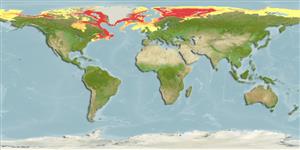Environment: milieu / climate zone / depth range / distribution range
Ökologie
seewasser demersal; tiefenbereich 6 - 1750 m (Ref. 117245). Polar; 83°N - 41°N, 180°W - 180°E
Circumarctic (Ref. 11954). Northeast Atlantic: northeast Greenland, Jan Mayen Island, northern coasts of Iceland, Faroes-Shetland slope, northern part of Barents Sea, White Sea and around Spitsbergen. Northwest Atlantic: Arctic Canada to Labrador and Gulf of St. Lawrence; possibly to Cape Cod in Massachusetts, USA (Ref. 7251). Arctic Ocean: Kara Sea, western part of Laptev Sea, Beaufort Sea and Arctic Canada. Subspecies(?) Lycodes pallidus marisalbi in White Sea only (Ref. 4695).
Size / Gewicht / Alter
Maturity: Lm ? range ? - ? cm
Max length : 26.0 cm TL Männchen/unbestimmt; (Ref. 4695); common length : 18.0 cm TL Männchen/unbestimmt; (Ref. 4695)
Kurzbeschreibung
Morphologie | Morphometrie
Wirbelzahl: 90 - 93. Pelvic fins small (Ref. 4695). Young with pale, yellowish-brown body, with 6-8 light and narrow cross bands which are more distinct on the dorsal fin; larger individuals lose the bands, becoming more or less uniformly colored (Ref. 4695).
Found on muddy bottoms (Ref. 4695). Benthic (Ref. 58426). Feeds mostly on endobenthic prey such as small bivalves, polychaetes and small crustaceans in addition to detritus. It seems to get the bulk of its food by burrowing in the sediment (Ref. 13532). Ripe females recorded in September in the Kara Sea (Ref. 4695). Minimum depth from Ref. 58018.
Life cycle and mating behavior
Geschlechtsreife | Fortpflanzung | Ablaichen | Eier | Fecundity | Larven
Anderson, M.E., 1994. Systematics and osteology of the Zoarcidae (Teleostei: Perciformes). Ichthyol. Bull. J.L.B. Smith Inst. Ichthyol. 60:120 p. (Ref. 11954)
IUCN Rote Liste Status (Ref. 130435)
Bedrohung für Menschen
Harmless
Nutzung durch Menschen
Mehr Information
ReferenzenAquakulturAquakultur ProfilZuchtlinienGenetikElectrophoresesVererbbarkeitKrankheitenVerarbeitungNutrientsMass conversion
PartnerBilderStamps, Coins Misc.LauteCiguateraGeschwindigkeitSchwimmstilKiemenoberflächeOtolithsGehirngrößeSehfähigkeit
Tools
Zusatzinformationen
Download XML
Internet Quellen
Estimates based on models
Preferred temperature (Ref.
123201): -0.9 - 4.9, mean 0.8 °C (based on 2262 cells).
Phylogenetic diversity index (Ref.
82804): PD
50 = 0.5000 [Uniqueness, from 0.5 = low to 2.0 = high].
Bayesian length-weight: a=0.00263 (0.00137 - 0.00504), b=3.22 (3.06 - 3.38), in cm total length, based on LWR estimates for this Genus-body shape (Ref.
93245).
Trophic level (Ref.
69278): 3.1 ±0.36 se; based on food items.
Widerstandsfähigkeit (Ref.
120179): mittel, Verdopplung der Population dauert 1,4 - 4,4 Jahre. (Preliminary K or Fecundity.).
Fishing Vulnerability (Ref.
59153): Low vulnerability (16 of 100).
